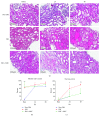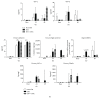Renal Ischemia-Reperfusion Injury in a Diabetic Monkey Model and Therapeutic Testing of Human Bone Marrow-Derived Mesenchymal Stem Cells
- PMID: 30155487
- PMCID: PMC6092988
- DOI: 10.1155/2018/5182606
Renal Ischemia-Reperfusion Injury in a Diabetic Monkey Model and Therapeutic Testing of Human Bone Marrow-Derived Mesenchymal Stem Cells
Abstract
Clinically, acute kidney injury (AKI) episodes in diabetes mellitus (DM) patients are associated with a cumulative risk of developing end-stage renal disease. In this study, we asked whether the severity of AKI induced by renal ischemia-reperfusion injury (IRI) is more prominent in DM than in non-DM control using a cynomolgus monkey (Macaca fascicularis) model. We also investigated whether human bone marrow-derived mesenchymal stem cells (hBM-MSCs) infused via the renal artery could ameliorate renal IRI in DM monkeys. The experimental data, including mortality rate, histologic findings, and urinary albumin secretion indicate that the severity of AKI was greater in DM monkeys than in control animals. Moreover, histological findings and qRT-PCR analysis of Ngal mRNA in renal biopsy tissue showed that hBM-MSC promoted the recovery of tubular damage caused by AKI. Serum analysis also revealed that the level of albumin and ALT was increased 24 and 48 hours after AKI, respectively, suggesting that AKI induced acute liver injury. We suggest that this nonhuman primate model could provide essential information about the renal and nonrenal impairment related to DM and help determine the clinical usefulness of MSCs in AKI.
Figures




Similar articles
-
Evaluation of Selected Markers in Kidneys of Cynomolgus Monkey (Macaca fascicularis) with Induced Diabetes during Renal Ischemia-reperfusion Injury.Comp Med. 2023 Oct 29;73(5):357-372. doi: 10.30802/AALAS-CM-22-000127. Comp Med. 2023. PMID: 38087409 Free PMC article.
-
The effects of glomerular and tubular renal progenitors and derived extracellular vesicles on recovery from acute kidney injury.Stem Cell Res Ther. 2017 Feb 7;8(1):24. doi: 10.1186/s13287-017-0478-5. Stem Cell Res Ther. 2017. PMID: 28173878 Free PMC article.
-
IL-17A improves the efficacy of mesenchymal stem cells in ischemic-reperfusion renal injury by increasing Treg percentages by the COX-2/PGE2 pathway.Kidney Int. 2018 Apr;93(4):814-825. doi: 10.1016/j.kint.2017.08.030. Epub 2017 Nov 11. Kidney Int. 2018. PMID: 29132705
-
Gene-modified Mesenchymal Stem Cell-based Therapy in Renal Ischemia- Reperfusion Injury.Curr Gene Ther. 2017;17(6):453-460. doi: 10.2174/1566523218666180214094253. Curr Gene Ther. 2017. PMID: 29446737 Review.
-
Mesenchymal Stem Cells in Renal Ischemia-Reperfusion Injury: Biological and Therapeutic Perspectives.Curr Stem Cell Res Ther. 2017;12(3):183-187. doi: 10.2174/1574888X11666161024143640. Curr Stem Cell Res Ther. 2017. PMID: 27781940 Review.
Cited by
-
Impact of administering umbilical cord-derived mesenchymal stem cells to cynomolgus monkeys with endometriosis.Reprod Med Biol. 2023 Sep 8;22(1):e12540. doi: 10.1002/rmb2.12540. eCollection 2023 Jan-Dec. Reprod Med Biol. 2023. PMID: 37693240 Free PMC article.
-
Transplantation of chicken egg white extract-induced rabbit PBMCs as a treatment for renal ischemia-reperfusion injury in rabbits.PLoS One. 2020 Dec 28;15(12):e0244160. doi: 10.1371/journal.pone.0244160. eCollection 2020. PLoS One. 2020. PMID: 33370374 Free PMC article.
-
The Anti-Inflammatory, Anti-Oxidative, and Anti-Apoptotic Benefits of Stem Cells in Acute Ischemic Kidney Injury.Int J Mol Sci. 2019 Jul 19;20(14):3529. doi: 10.3390/ijms20143529. Int J Mol Sci. 2019. PMID: 31330934 Free PMC article. Review.
-
Diabetic Kidney Disease Alters the Transcriptome and Function of Human Adipose-Derived Mesenchymal Stromal Cells but Maintains Immunomodulatory and Paracrine Activities Important for Renal Repair.Diabetes. 2021 Jul;70(7):1561-1574. doi: 10.2337/db19-1268. Epub 2021 Apr 15. Diabetes. 2021. PMID: 33858824 Free PMC article.
-
Exosomes derived from mesenchymal stem cells in diabetes and diabetic complications.Cell Death Dis. 2024 Apr 17;15(4):271. doi: 10.1038/s41419-024-06659-w. Cell Death Dis. 2024. PMID: 38632264 Free PMC article. Review.
References
MeSH terms
Substances
LinkOut - more resources
Full Text Sources
Other Literature Sources
Medical
Miscellaneous

